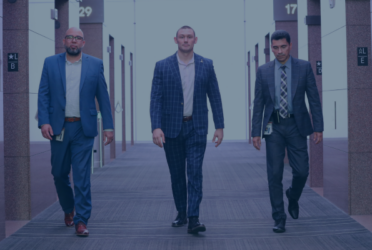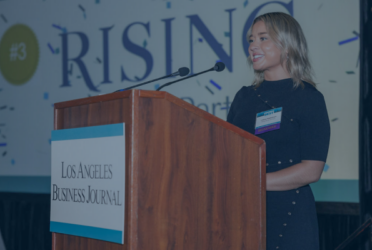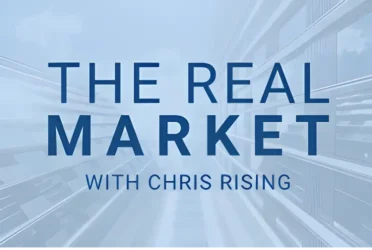The Real Market With Chris Rising – Ep. 22 Gabriel Safar

01:27 CR: Welcome to The Real Market with Chris Rising. I’m really pleased to have Gabriel Safar with me today. He’s the co-founder and CEO of LeasePilot. And for those of us who’ve spent any time in the law business or happen to read a lot of leases, or have to deal on the landlord or a tenant side looking for some relief on how we get at lease document done, it would be a great thing for our survival in this business. So I’m pleased to have Gabriel on the phone. Gaby has a product that is getting more and more use in the market. It’s an exciting product and I think it speaks for how real estate has fundamentally changed in the last few years. So Gabriel, welcome to The Real Market and thanks for being here.
02:09 Gabriel Safar: Well, thanks for having me, Chris. I’m looking forward to the opportunity to have this conversation.
02:13 CR: Well, what I’m excited about is, on my podcast we’ve had… Really, was started with the intention to try to have people who you would normally see at a ULI or a PRIA and didn’t really have access to, and we have people like that. But what the podcast is also evolving into, is trying to really be in the cutting edge of what’s happening with technology in real estate, how buildings are operated, how deals get done. And we were introduced several years ago. And I guess some full disclosure, I have made an investment in your product. But it’s really exciting, so I wanna give you the platform a little bit here of what LeasePilot is, where you are in production, and just a little bit about the company.
03:01 GS: Okay. Well LeasePilot, is a lease automation platform. That sounds a bit misleading. We haven’t been able to find any better words to describe it. But anyone who’s done a fair number of transactions, understands that there’s a lot of predictability in a lease, both predictability in the initial construction of a lease, but also even predictability in things that a tenant may ask for and responses that a landlord may give to what those requests are. So any predictable behavior, is great for computers. And so we have an automation platform that allows landlords to quickly set up a lease and then negotiate a lease using automation that stores predictable responses in a database. The other real powerful component of LeasePilot is, we’ve married that automation with a unique text editing capability that allows for the automation and the text editing to live side by side. So, you can freely manipulate any bit of your lease and there’s no limits on how you can customize it. However, right after you start changing sentences, there you go, you can make your selections and say I wanna hit a couple of buttons and my lease changes because I just realized the tenant was a franchise in nine places and the lease just changed.
04:36 GS: And I think the last piece which is really important about LeasePilot, is because we have this ability to automate. And we’re on a web-based platform, we actually capture all of the underlying information in the lease, both the structured choices that someone makes, as well as every single text edit. And that allows us to do some remarkable things. The simplest is, we can automate an abstract. One step further, is we can populate your ERP systems, such as property management, whether that’s a MRI or Yardi etcetera, without having to retype anything in. And as you go forward, there’s more analysis we can do on a lease by capturing at a very granular level all of the underlying terms and we can relate them to each other to develop insights.
05:29 CR: So it sounds like you have declared war on the first year leasing associate. Because when I was a first year leasing associate, I remember my mentor was a guru in the leasing side of law, Michael Meyer. Michael Meyer, who’s now with the DLA Piper, would tell me, “Chris, you gotta just make a game of it. You gotta just see if you can find the typos.” And that’s how you learn about leasing. But I have to imagine the first thing that a lawyer says to you is, “You’ll never replace us. Not a chance. Not gonna happen.” How would you respond to what your technology does if a law firm or… Either a law firm or a landlord says to their lawyers, “I want you to use this.”
06:15 GS: I think it’s a great point. I’m glad you brought it up. One, our customers are the landlords themselves. Their inside counsel or outside counsel, can use it, but the license holder would always be the landlord. And because that’s fundamentally, they’re the principle, they’re the ones with the most at stake and they’re the ones that can use the data. I was that lawyer, and for me, what LeasePilot represents is a relief. Why? I didn’t go to law school to monkey around with text and try to map a document and manipulate the seven different places that change when you go from having a guarantee to no guarantee, that’s routine and rote. And I don’t think that’s where any lawyer wants to spend their time. So we look at ourselves as not replacing lawyers, but we enable them. And what do we enable them to do? Think about deals. Try to understand what matters and then be responsive. We’re moving into a world which is increasingly tenant/customer centric. And to wait a week for a turn around on drafts, is just too long. And you want your leases to be in front of your tenants as fast as possible, so it’s on the top of the queue, and LeasePilots let’s you do that because drafting is hard. And if you can take that hard work out of it and just allow lawyers to think, they can get a deal done faster.
07:45 CR: So how is your product not just a glorified Red Line from Microsoft Word?
07:52 GS: Another great question. LeasePilot is effectively nothing like Microsoft. What Microsoft Word does is not that different than a typewriter, it’s just a software version. It strings together letters and those letters make sentences, and there’s no underlying understanding of what’s there or what that means. It’s just again, an alphabet. At LeasePilot, we come from the perspective that a lease is a structured transaction and has components that have meaning. And so what we’re able to do, is during a very simple and quick onboarding process, we construct your lease from its constituent parts. When we do that, that allows you to have on the left hand side of our application, a whole suite of document automation tools that you can hit a button for. Again, I’m using retail as an example ’cause it just comes to mind, but you add a percentage rent provision.
09:01 GS: Next thing you know, your radius restriction provisions need to change, you need to have provisions about reporting requirements that needs to change, you may even have default provisions that change. All of that, there’s intelligence in the system that you hit one button, and again, eight places in the lease will change in a predictable way. That’s something that word can’t do. The other thing that word can’t do is, when you manipulate the text in LeasePilot you’re not manipulating text per se, you’re actually directly manipulating a database. We create the illusion that it feels like text and looks like you’re looking at a traditional lease document, but what you’re looking at is an aggregation of over a thousand plus database fields, that when you touch a piece of text, we can associate that textual change with an idea. So you change text in the covenant of quiet enjoyment, we know that and we can send that to your property management system, and aggregate that and put it into an abstract.
10:09 CR: So when I hear you explain that, it almost you have to make the analogy that you’re not living in a word document, but you’re really living in an Excel spreadsheet if you’re talking about creating these cells. Is that a more appropriate analogy for what LeasePilot is?
10:25 GS: That is a better analogy than Word. Databases have evolved quite a bit. And though a traditional table is one form of database, you have document databases right now, which is another way of structuring information, but the idea is the same that you are dealing with structured information at all times.
10:48 CR: So how close… Let me re-state that, this question. So I’ve had people on the podcast who are VCs. I’ve had people talk about Bitcoin and cryptocurrency and Blockchain. And over and over again, the concept that comes up, is this concept of smart contracts. And the times I’ve talked to people about it, I say one of the problems that has yet to be solved, which I think will get solved, but is this idea that, “How do you fractionalize a building when there’s a lease that has a 100 confidential… There are leases that have hundreds of confidentiality clauses. You’d have to go through all those, you’d have to get the tenants to agree that this probably could be somehow public or what it could be.” Does LeasePilot get us closer to the ability to have smart contracts that work for real estate or are they unrelated? Or what would you say about that connection?
11:43 GS: I think of LeasePilot as a foundation. Once your information is digital, there are tons of applications that you can build on that, one application of which are smart contracts. I think the question of confidentiality, is a really important one. The question you need to ask is, “What information are you using in what context?” So let’s say for example, one of the experiences I had as a lawyer, was dealing with commencement date certificates. Like eight out of 10 institutional leases don’t have any dates in them because you don’t know when the landlord’s gonna finish construction. And so you need to have this commencement date certificate after the construction is done, and that’s gonna cure or finalize all the dates. Maybe five times out of 10, people forget to do that commencement date certificate, that’s a great application for a smart contract. And when you apply that with LeasePilot, there’s no confidentiality issues ’cause it’s between the two parties that sign the agreements. So you really need to look at the applications. We have a blockchain application that we’re working on right now.
12:58 GS: Again, this is building on the idea that a lease is digital. And you can say with your lenders for example, why when you’re financing an institutional building with a couple of hundred tenants, why do you need to have all of those leases re-abstracted and re-read? All of that information is in people’s computers, right? Well, the problem with that is that a lender can’t trust that a report that you generate from MRI or another ERP system is accurate. Well, if LeasePilot generates your lease, we can hash your lease, and put a hash of that on a blockchain and then we can run a report with only the information that the lender needs and the lender cares about. Are there SNDA provisions? Does the lease automatically subordinate? The stuff that normal people don’t care about but the lender is gonna care immensely about. We can write that over a blockchain and then when the lender gets a report, they say, “I don’t believe the report,” and you say, “No problem.” Hit a button and it gets verified against the blockchain. There’s no confidentiality issue there because the parties who are entitled to that information, that’s what they’re getting, is what they’re entitled to.
14:13 CR: So just hearing you talk about a lender. The name of the company is LeasePilot, but it sounds to me like there’s a whole lot of other documents, financing documents, maybe even purchase and sale agreements. I imagine this could go over to equipment leasing and things like that, that the technology that you have is appropriate for. Am I correct on that?
14:32 GS: That is true. Right now we’re highly focused on leasing and the real estate industry. And we’re very determined to move from A, the heart of our platform is a system that provides teams that draft leases, support to make the process of doing deals easier and to help people get deals closed faster. That system that we’re developing, has obvious applications for other types of transactional behavior. Such as loan documents, equipment leasing and others. But in the short term, what we’re really focused on is going from that ability to draft quickly, get leases closed quickly, to then thinking about how do we make the information that we’re able to collect as useful as possible to our customers? And the first way that we’re doing that is automating abstract because that’s just a no-brainer. The second way that we’re doing that is through pre-populating different types of systems, whether it’s, again, an MRI with a property management system, or even sending information back and forth between VTS, and LeasePilot or Salesforce and LeasePilot.
15:53 CR: So I would imagine that there’s some push back. If you talk to an attorney who does this for a living, he says, ” You know what, every deal is so unique. You you can never automate it. ‘Cause I’ve got to use my special gift of being able to craft language in a lease that fits this building.” How would you respond to a prominent attorney who would say something like that and how it relates to LeasePilot?
16:23 GS: My response to them would be, we aren’t trying to automate everything. If someone’s gonna say that the lease doesn’t have predictable elements to it, that you can speed up through automation, it’s just not true, and I don’t think they’re credible. And there’s really not much of a conversation that you can engage in if someone’s not able to acknowledge the way that our industry works. And I would say at that point, if they’re outside counsel, they wouldn’t get very far with their client. Because we engage first with the real estate owners, and the real estate owners do enough transactions that they understand. There’s certain ways that we deal with at a business level, assignment and sublet rights.
17:15 GS: There’s certain ways that we deal with renewal options, and that’s just a fact and you can model that. We do recognize though, that words need to change, but that doesn’t bother us because we model the ideas and the business concepts. You can think about assignment and sublet as like a bucket, and you can have different options and different choices, but you can fill that bucket with different words, those words all say the same thing. They might say it in a different way, that might be important when you’re in litigation. But we’re not in litigation and we can give you that freedom to be able to position anyway you want for the potential of ligation without interfering with the ability to automate predictable elements of the lease and drive radical efficiencies in timing and get deals signed much much faster.
18:06 CR: So I guess one of the questions that comes to mind, if you’re an owner of a property and you said, “Hey, LeasePilot’s for me.” How does the discussion go with the tenant who says, “I don’t wanna use it,” or “I don’t have the time. You’re actually slowing us down.” Talk a little bit about how an owner would present that to a tenant on why this will help us get a lease done much quicker.
18:32 GS: That’s a great question. So I got two-way answers to that. There’s today and tomorrow. Today, the tenant doesn’t need to touch it. We can convert every document into Word. And they’re perfectly formatted Word documents, so you can send… You can create a lease in LeasePilot, you can send it to a tenant on the other side, the tenant can manipulate it and do whatever they want the way that they do that today. And then they can send back a clean copy or a red line to the landlord. The landlord, then can use LeasePilot to run red lines and run comparisons and then manipulate the lease using all of the second and third draft, automation that they have. For example, a tenant, it’s predictable that they might ask for on a second draft cap on CAM, or in office they might ask for certain audit rights. You know how the landlords are gonna respond to that. When you’re a specific landlord, you have language. You can choose the LeasePilot language or you can use the tenant’s language and manipulate the lease. Where we’re going though, and actually as a preview in October, where this October, we’re gonna be releasing a version of LeasePilot, that when a lease is done, a link will get sent to the tenant and there the tenant will have access to the landlord’s lease without the automation.
19:55 GS: They can manipulate it, just as if it were a Word document, however, they’re gonna have a number of different communications tools that will allow them to more and efficiently engage with the landlord. When the tenant then manipulates that document and then indicates as ready to go back to the landlord, the landlord has a whole set of tools to be able to speed up their drafting. But why would a tenant use this? Well, we’ve interviewed dozens and dozens of both institutional tenants as well as Mom and Pops, and they have a vested interest in speeding up their leasing process. And they’re not in love with Word. Word’s a pretty poor piece of software for manipulating leases. And LeasePilot’s specifically designed to help them get a lease done faster. And so, we’ve seen universal interest and support among tenants of saying, “If you have a better solution, I’m all for it.”
20:58 GS: The other thing that people… That we’ve seen, is that red lines are really a disaster. They’re hard to read, they’re difficult to follow, it’s easy to make a mistake. And so, when landlords and tenants are manipulating leases in LeasePilot, we have a whole set of tools that simplifies the process of red lining so that you can very easily and accurately see what’s changing in a lease and you can manage and deal with that in a more efficient way. That make sense?
21:32 CR: Yeah, it certainly makes sense to me. Let me ask you this though, I mean, ultimately, this moves everything towards a digital format. Where are we in terms of just contract laws that relates to DocuSign? And at this point, I can’t imagine a lender being okay if we had a lease done that didn’t have a wet signature or it didn’t have their attorneys sign off. Can all of that be implemented or is it implemented into LeasePilot? So those kind of check the box things that seem to be still routine, go away?
22:13 GS: Well, whether an attorney signs off or doesn’t sign off on a specific lease, isn’t something that the LeasePilot platform determines. So with most of our customers right now, the people using LeasePilot in the most intensive way, are attorneys. And they’re seeing this as drafting facilitation. So before the lease is finished, it’s the lawyer that says we are done. We have some customers that are saying, “Huh, if the lawyers set up the leasing framework in the beginning, then we don’t necessarily need them to do all of the drafting.” And we actually have an interesting blog post on this called, The Call Center Model, where trained leasing professionals can negotiate the lease. And then when you hit something that’s not captured by the automation, it can get escalated to legal team, and then the legal team can make a change and sign off on it. But at the end, it’s our customers, the landlord, are saying that this lease is done and we stand by it. So I don’t see any issue there.
23:21 GS: What can happen at that point is, you can download into Word and wet ink signature it, or download it as a PDF, or you can integrate with DocuSign. From my understanding, and not giving legal advice here, is that most jurisdictions accept DocuSign and digital signatures as legal, valid and binding. From my perspective, I think they’re absolutely superior because it’s much harder to manipulate. You know exactly when it was signed, who signed it. There’s a digital footprint and signature that authenticates it. So most jurisdictions accept that. Many landlords are moving to DocuSign as a platform. There are some jurisdictions that require leases to be notarized, in which case, I don’t believe DocuSign has a solution for that today, though I do know that it’s something that’s being worked on. And I do believe, again, this isn’t legal advice, but there are statutes and other… There’s some legal guidance is being given on how to implement digital versions of notarized signatures.
24:39 CR: Let’s take a step back here. So you spent 10 years as a lawyer. You went to BC for law school and you went to Tufts Undergrad. How does someone who is that… Maybe in 10 years, you’re at partner level, probably started a family and all that. What gave you the entrepreneurial bug to kinda jump off the diving board and start a company that was basically at least… Well, not in practice. At least in theory, is gonna scare a lot of lawyers that you’re coming after their business? So I think you’ve given a good explanation why it actually becomes much more of a tool for lawyers and not to hurt lawyers. But when you started this thing a few years ago, this was a big leap. Tell us a little bit about that.
25:24 GS: Yeah, I think frustration is the thing that comes to mind. I was pretty lucky as a lawyer. Early on in my career, I started developing my own book of business. And when I did that, the firm that I was working for, hired me, a Business Development Coach. And that business development coach, was really, very very thoughtful person. And he said to me, “You should not be thinking about developing your practice for tomorrow, but you should be thinking well beyond that. And what does the future bring for the practice of law? What does the future bring for the real estate industry? And what role are you gonna have in that?” And he recommended I read a couple books. And those were books by a professor out of I believe Oxford or maybe Cambridge in the UK. And his name is Richard Susskind, and he had a book called Tomorrow’s Lawyer. And it evaluated how technology is changing the practice of law in many different fields and how regulations are changing and what that will mean for the future. And when I read that book, it was like alarm bells went off and I couldn’t look at my practice the same way at all. And so every time I did a lease, all I could do was complain.
26:52 GS: And I complained that, “Why does this take so long? My clients are on my back because they want me to do something faster, and I just can’t ’cause it’s hard. My bills are too high and I’m getting enormous pressure, why can’t… I just can’t get my bills lower than they were.” And then at the end of the day, you just give this Word document that nobody cares about. And it was incredibly unsatisfying that you work so hard, you spend so much time, you’re arguing about bills, and then you’re delivering this really high priced, laborious crappy product at the end of the day. And at a certain point, I just couldn’t keep complaining about it and decided to do something. And so that’s how LeasePilot was started. There was just this problem that we needed to solve. We also at the same time that a lot of these ideas were gestating, VTS had launched their platform. Nick had been a broker and I think came at VTS from a similar angle as a practitioner who was wrestling with this idea of, “Why is this so hard? Why is something that should be simple, so hard? And that’s really where LeasePilot comes from. It’s, something’s harder than it has to be when you look at modern tools that we have available to us today.
28:15 CR: I really like the way that you talk about VTS solving a problem because I think it makes a little more sense for the non- lawyer in the real estate business. When you’re saying that, what they were solving, was the idea that everything was Excel spreadsheet- based, leasing reports that you really… As I say a lot, VTS has probably given me back seven hours a week, that used to be literally seven different leasing calls and going through lists that were stale by the time they were done. But when you saw that and then you also look at what you were doing, I mean, this is a big jump because the law business, is a huge business where people take great pride in their ability to draft language. And at the end of the day while you’re not full frontal attack on that at all, you’re trying to be a system that supports that, a software system that supports that. That’s a big leap from telling your client, “Hey, pay me $150 an hour or $500 an hour, and I’ll make sure that this lease is okay.” So when you did that, did you realize that there was a jumping off point that was gonna be very… Probably not impossible. Everybody can go back and keep your law license active. But you were going against an industry… You were swimming against the tide, let me say that. How did you look at that?
29:38 GS: You know, I haven’t felt like we’re swimming against the tide, because we have outside counsel on our system and you would think, “Okay, these outside counsel would push back.” They haven’t. Why? When I was a lawyer, I realized that I wanna service my clients and I don’t want to charge $600, $700 an hour, to do busy work. If I can spend my time doing thoughtful value-added work, then I’m delivering a better product for my clients and in turn, I am more valuable as a service provider. I do really think in the legal community, there’s an understanding that we need to provide value. And if any lawyer’s saying, “Stop, I wanna charge $800 an hour, to do menial secretary work.” That’s someone that you shouldn’t be working with. And the interesting thing also I think about the legal industry is, traditionally, their end was to produce a document. Here you go, I have a lease, it’s a bunch of words, now it’s yours. I think lawyers are starting to understand that our job is not just about producing a document and walking away, we’re part of a larger system that’s in leasing the revenue stream for a real estate company, and that touches lots of different elements of what a real estate company needs to do.
31:13 GS: And when you understand that and you understand your place in the process and someone comes and says, ” Huh, I’m gonna help you engage in a more responsive and productive way with your clients and help you deliver more value.” I don’t think thoughtful people are opposed to that. And we’ve not really had meaningful pushback from outside counsel or lawyers. Our customers is driven by the legal function, has been saying, “Help us, we’re drowning. How can you help us?” And lawyers have the highest, I’d say, unhappiness quotient, when it comes to their job satisfaction. And why is that? Well, because like me, it wasn’t very satisfying to deliver a product that people didn’t care about very much. And so I think there’s a good story for lawyers here.
32:13 CR: Well, let me ask you this, how does a lawyer who’s spent 10 years pricing law, become a computer software engineer?
32:21 GS: I’m not, I’m still a lawyer. I think that’s one of the important things of what LeasePilot brings to the table, is I have an amazing CTO that I work with, Itzik. And he’s the engineer and he does the computer work. And we’ve also hired other lawyers at LeasePilot and so we have a Director of Customer Success, Nadine Nezzie, who was formerly a general council of a law firm. And that allows us to engage with our… Excuse me, not a general council of a law firm, she was general council of a real estate company. What that allows us to do is engage with our customers where they are in the language that they’re accustomed to, and not focus on the computer component of it, is to focus on what are you trying to do? And we’ll get you there and we’ll help you accomplish your goals. And that’s really I think what’s special about LeasePilot.
33:14 CR: So how big a company is LeasePilot today?
33:17 GS: We have 15 people that we’re working with. And that’s one way of measuring it. There’s a bunch of different ways. But because that’s the most direct, so we have 15 people.
33:30 CR: Okay. And tell us a little bit about who your customer base is? Who’s using LeasePilot today for their business?
33:39 GS: So we have a number of institutional landlords both in the retail and office sectors. They range from publicly traded companies to smaller private companies. Groups have… We’ve one group with 24 million square feet of retail space in the Mid-Atlantic and Midwest, to the largest owner of real estate doing about 1000 deals a year in the mountain regions. And everything to publicly traded company on the East Coast with a portfolio of 20 million, growing to 30 plus million within development pipeline. So we’ve been fortunate to work with a group of phenomenal forward-thinking customers that have adopted LeasePilot and they’re universally achieving some really amazing results when it comes to speeding up field times.
34:41 CR: Is there anything unique about these clients that you think… At least from your perspective, what made them either search you out, or when you searched them out, they said, “Yes, this makes sense and I’m gonna do it.” Is there a client profile that you think LeasePilot is really perfect for?
34:57 GS: Well, at this point, given the ideas underlying LeasePilot are new and I think just from this conversation, that we can see it requires us to do some educating on behalf of the industry and our customers or our prospects about what LeasePilot means, how we fit into their overall strategy, where we can add value. We’ve been able to, like, other startups, engage with early adopters, and that’s a pretty vague term. But it’s been companies who have been thinking, “How can I find a competitive advantage to build a better business and how can I use technology to do that?” Companies that are thinking about that, and they’re open to changing the way that they do work, those are the right companies for LeasePilot. They’re not easy to find, but fortunately, there are so many different venues for discussing real estate technology and there are so many venues for us to share our ideas, you know we’ve been able to connect with those customers.
36:12 CR: One of the things that comes to my mind is… And I think you hit a really important point for owners of real estate. Which is that, typically, and I just haven’t seen it change much in my 25 years. It takes somewhere around 60 to 90 days between yes, here’s the LOI and let’s go back and forth before a lease gets signed. And it’s one thing if you’re talking about a hundred thousand square-foot lease or a million-square-foot lease. But where it gets really frustrating, is when you’re dealing with a tech company or a company that’s well-versed in technology and you’re both pushing hard, and you’re like, “Hey, it’s a 3000-square-foot lease. Can’t we get this done?” That to me, is where LeasePilot really jumps out as… And not that you can’t do it on the bigger ones, but I get the long-standing fear that goes into real decision-makers. How have you been able to grow? Make the argument to those tenants or to the landlord, that there’s a real need? It makes sense to me. But are you able to anecdotally say, “Here’s our history, and this is how we’ve shortened the time.” Is it an argument for the case or do you have anecdotal evidence about it?
37:30 GS: Yeah, it’s pretty easy when you’re just talking about something as simple as transaction time frames. You can start with, many times asking, “Well, how long does it take you to turn around the first draft of the lease?” And it’s not unusual to hear people say a week. You’re like, “Okay, why?” Why does it take a week to turn something around? You have the LOI. It shouldn’t be that complicated but the process of communication is slow, the process of modifying documents is slow, and we’ve been able to show with our customers, what would typically take three hours of work can be done in 15 minutes. And not only can you change three hours to 15 minutes, but you can change who does that three hours or three hours of legal work, or work that was being done by a lawyer. I don’t know if you’d categorize setting up a lease legal work per se, parts of it are but not all of it, that can be done by an admin team.
38:33 GS: What does that mean in practical terms? Well, for an in-house lawyer that has a ton of deals on their plate, freeing up three hours reasonably can take a week. For an admin to free up 15 minutes, that should be any day. So you go from five days to same day on getting transactions out. When you’re talking about, especially institutional repeat tenants, that can be the difference between having your lease next in queue or at getting underneath someone else’s lease. And that’s just one example, it’s a very clear, easy to understand example of how you can just drive a week out of the process right there. Then you start talking about second drafts, second drafts are exhausting. That’s where all of the effort is, and what we’ve been able to see is that half of the changes that go back and forth are things that are totally predictable.
39:30 GS: And so you can automate that and drive dramatic time savings, and again, shave another four days off through a week. You add that up, you go from 90 days to maybe 60 days, maybe less. And with some of the changes that we’re making, with bringing tenants on to the system and solving communication challenges, we’re hoping to bring that into 30. I think, an interesting analogy is other industries other than LeasePilot, or other than real estate, and if you think of space in for the real estate industry is our inventory, there are very few other businesses that would accept a 90-day lag between deal terms to moving that inventory. And in the real estate industry that’s acceptable, because there was no other alternative. But if you look at the retail industry with the Walmart and the billions that companies invested in supply chain management, optimization, and just-in-time manufacturing, etcetera, this state of affairs where it takes 60-90 days just to go from terms that are the key business terms to finalizing a document and getting it signed is totally unacceptable by any sort of standards that other industries would be judged by.
41:01 GS: And that ties into another idea where I think traditionally that may have been okay, when real estate was owned mostly by local companies, but as the real estate industry becomes increasingly institutionalized, and more and more institutional capital is coming into the real estate industry, the expectations are gonna get ratcheted up. And that’s where I think LeasePilot is part of a broader trend that can help the real estate industry meet increasingly stern and reasonable expectations.
41:36 CR: Well, and I think, a case in point is, I think, when you look at what WeWork is doing and being such a large lessee of real estate but one of their big pitches is let us do the complicated leases with the landlord, here’s our… On an iPad, membership agreement, and you could be a member for three years at this price, or a year at this price of [42:00] ____. And they’ve absolutely simplified it, and I think unless we all believe that WeWork’s credit is the greatest in the world, I think sometimes you wanna diversify from just one tenant in all your building. And so, I really think that we’re being driven to these shorter times because the market is saying, “It really doesn’t make any sense.” Well, let me ask you this, so that means that you are probably in a constant state of iterating this software, trying to make it better. You’ve got about 15 people, but does that include software engineers around the globe that you’d be using to write code, how are you constantly iterating to keep up?
42:39 GS: Yeah, so we have an Agile Software Development shop, that means that we have a backlog of features and stories that’s constantly evolving and we’re tackling it nonstop and every single week we have a deployment and our software is evolving and changing week by week, and it’s exciting and dynamic. And so we have our team that’s on-our premises, and they are dedicated to LeasePilot, but we also work strategically with outside vendors that help us on specific problems that they’re specialized in helping us with. So we’ve gone and talk… We’ve worked with different software development shops in the US. Recently we did a big project with thoughtbot in Boston. We work with Pivotal Labs. We’ve worked with very successfully, a group out of Israel, that we think the world of and we also have development teams that we work with in the Ukraine. It’s not possible to take all of that expertise inhouse. And so…
43:53 CR: That makes sense. That makes a lot of sense.
43:55 GS: We develop a core team inhouse, so we retain all the knowledge and don’t lose that when we change vendors, or software partners that we work with and then we focus our software partners on very specific problems that we need to solve.
44:11 CR: So it wouldn’t be my podcast if I didn’t ask you. How do you manage your team internally as it relates to using software? Are you an email-based company, do you use a project management software like an Asana or how do you run the ship internally to be able to communicate with all these different inside and outside vendors?
44:33 GS: That’s a great question. We use lots of different stuff. We’re a small group so we still have regular meetings. We do a stand-up every single day, and so every day we sit around a table as a group and we talk about what happened yesterday, and what happens tomorrow as a Agile Software Development shop, Agile principles have infiltrated everything that we do even on the business side. And so what that means is that we’re constantly thinking about getting alignment of our teams so that we communicate, and we understand what direction we’re moving in, and where there are problems. So we have weekly retrospectives with our teams in terms of technology that we use, we use Slack. Slack has been an amazing tool for us to collaborate with many of our different outside vendors ’cause we set up specific channels for projects, and then you can integrate directly with the Slack channel, a video chat that allows us to both communicate, share screens but also look at each other and communicate, it really feels like we’re in the same room as well as have an ongoing communication. The other tool that we use quite a bit is Trello. I don’t know if you’re familiar with that?
45:58 CR: Mm-hmm. Yes I do.
45:58 GS: It’s just a very simple project management software. We’ve experimented with Asana but this has more moving pieces, and we try to keep things simple. And then the other thing that we use this… This other software development site that we love is a platform called Pivotal Tracker.
46:13 CR: Let me ask you, what’s your view of… You said you have a lot, you’re small group, you still have a lot of in-person meetings. Do you think that’s sustainable long-term? Or do you think that just the demands of where you need to be and especially with a sales force, do you think it will be much more of a remote interaction?
46:35 GS: So we have a lot of remote teams that we work with, and I think working with teams remotely is excellent, and it’s an imperative, because talent is so hard to find, and you need to hire talent and use talent where it is. That said, I do think working remotely requires punctuated in-person meetings and they have to be highly structured those in-person meetings. So the the engagements that we do really evolve or revolve around alignment building, goal identification and being clear about what our mission is and when you hire really smart people and everyone’s clear on what the goals are and what the priorities are, it’s amazing what you can accomplish and you need fewer meetings though you still need to have those in-person meetings to set those alignments and goals. And so I do think that’s very scalable.
47:39 CR: So let me ask you this so if you… We’ve used Slack in the past and things like that, and I think Slack has a place, especially more on the software side, that I think than the side of the way we would use it. But you’ve got a wife and two kids, you’re a startup company, you are connected a lot. And tell us a little bit about how do you manage all those notifications that constantly come through.
48:07 GS: Yeah.
48:08 GS: I miss a lot of… I have to be honest with you, I’m terrible. It’s hard because I’m looking at, I’m getting instant messages all the time, I’m getting emails, I’m getting Slack. I think one of the ways that we’re trying to manage it is different types of communications go into different channels. So quick and dirty things that are project-based often happen in Slack. More meaningful communications that require some sort of thought and analysis often happen via email. But I do think communication is tough and increasingly, you see applications are embedding communications in those applications to reduce the confusion and email clutter. And that’s one of the things that we’re doing at LeasePilot is as we bring tenants on to our platform, you can actually load the communications into LeasePilot, so you have a history and trail on a specific transaction, and that will help give people a place where you know, “Here are all my communications about a transaction.” You can tie that with notifications. So, if there’s activity in a given place like I often get a Slack notification that there’s activity on Slack, then I can go there and check it. And LeasePilot will do much of that same thing. And that’s relatively effective.
49:41 CR: I think that’s amazing, and I think that’s an important part about LeasePilot is this ability to compartmentalize a lease negotiation and discussion all in one place. ‘Cause I just think that’s very valuable. Well, you also, you mentioned to you do a blog post. Can you tell a little bit about how active you are on social media, and maybe your Twitter handle and things like that?
50:07 GS: So we have a blog post on our website and we’ve really been trying to focus on thinking about… Many of the ideas that you and I are engaging on right now and developing thought leadership around say industry wide problems, and giving our take on them. So our main interaction has been through writing, I call them media informed pieces. We have a number of articles on subjects such as call it Getting your outside counsels on fixed fees and loving it. And that’s how groups that use outside counsel, and have lawyers paid by the hour, can use efficiency to sort of share the winnings with their outside counsel and get something that really matters to many real estate companies as fixed fees. We have blog posts on things like what we call the Call Center Model of a lease negotiation, where you can have non-lawyers, doing more and more of a leasing, particularly leasing reps, you think, they’re the ones that are closest to the deals. They should actually have more freedom to structure these transactions, they can use LeasePilot to do something like that. And you elevate the issues that are unique to lawyers, and lawyers sort of only get involved where it makes sense to have legal expertise. Those are the types of ideas that we’re exploring through our blog posts on our website that we then sort of distribute via mainly Linkedin.
51:42 CR: Terrific, and I wanna… We’ll wrap this up. It’s been a great conversation. But how far do you think we are away from living in a world where LeasePilot talks to VTS. Can talk to whatever my project management is so that these worlds become more seamless.
52:03 GS: We’re there. We do that now. We can pull informations from VTS and send information from VTS. For example, LeasePilot’s not gonna manage your stacking plan. And we don’t wanna manage your stacking plan. VTS manages stacking plans. They might have the negotiation as part of an LOI and they have information that may or may not get modified during a lease negotiation. We can then once a lease is done, send that information back to VTS. We can do that today. Today we have an API with MRI and when a lease is done your MRI set-up can be completely filled in with all of the terms without having to do anything. So, we’re there.
52:49 CR: Yeah, well, that’s…
52:50 GS: We just need to… We just need to let people know we’re there, but don’t realize it yet.
52:54 CR: Well, that’s terrific. Well, I wish you nothing but success with LeasePilot. So our audience, I think it’s an amazing product. How would our audience figure out more about LeasePilot. What’s your website? And I did ask if you had a Twitter handle. But how can they learn more about LeasePilot?
53:13 GS: One of the ways is we distribute a lot of content via LinkedIn. So, we can have people follow us, if you go to LeasePilot on LinkedIn, you can follow us and you’ll get a lot of content. Also, there’s our website, which is www.leasepilot.co. And anyone can reach out to me any time which is [email protected]. We’re at most of the major real estate conferences. So we’re at almost all the ICSC events. We will be at ULI and a number of other trade industry events throughout the year.
53:57 CR: Terrific. Well, I’ll see you in Boston for ULI. I think it’s gonna be a great fall meeting. I really appreciate you taking the time to be in the podcast, and I think that there will definitely be some follow-up ’cause I really think this is an important technology that’s gonna really make a difference in our industry. So thank you so much Gaby.
54:17 GS: Thank you Chris, I really appreciate the opportunity.
54:19 CR: Well, thank you Gabriel. That was a really interesting conversation, I appreciate it. For our audience, I’d appreciate it if you would follow us on Twitter @chrisrising. And don’t forget to subscribe to the podcast. You can go to our website, chrisrising.com. You can go to Apple Podcast and look for The Real Market with Chris Rising, or any of the other podcast platforms. I appreciate it, thanks so much.










 Podcast
Podcast